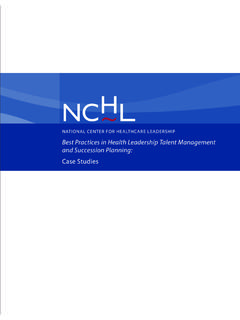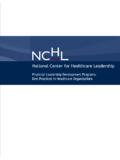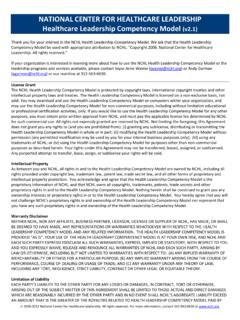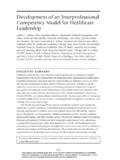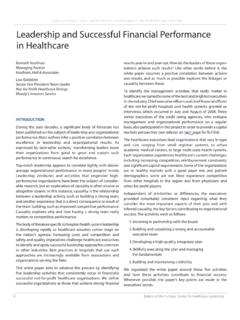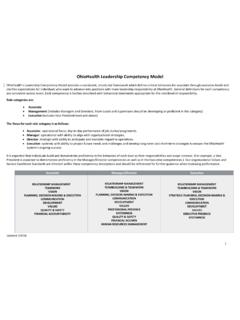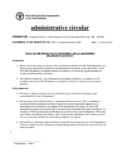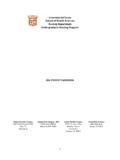Transcription of National Center for Healthcare Health Leadership ...
1 National Center for Healthcare Leadership Health Leadership Competency Model SUMMARY The NCHL Health Leadership Competency Model was created through research by the Hay Group with practicing Health leaders and managers across the administrative, nursing and medical professions, and early, mid, and advanced career stages. In addition, the Competency Model incorporates benchmark data from other Health sectors and insurance companies, and composite Leadership competencies from a group of global corporations. Although Health delivery underscores the study, the benchmarks incorporated into the development of the Competency Model give it validity for Health in its widest sense.
2 This summary version of the model provides background on the behavioral and technical competencies identified by the research. The full model contains levels for each competency that distinguish outstanding Leadership at each career stage (entry, mid and advanced) and by the disciplines of administration, nursing, and medicine. Purpose of the Health Leadership Competency Model NCHL's goal is to improve the Health status of the entire country through effective Health Leadership by: Establishing core competencies for Health leaders at all levels of the career cycle Strengthening the practice of Health leaders with academic research Defining continuous learning opportunities for Health leaders Increasing the diversity of Health leaders Consistent with this goal, Leadership competencies are defined as the technical and behavioral characteristics that leaders must possess to be successful in positions of Leadership across the Health professions administrative, medical and nursing.
3 The Competency Model serves as the basis for focusing training and development initiatives for Health Leadership from graduate education through the course of their careers. The Competency Model provides a template for selecting and developing leaders who can meet the challenges of 21st century Health . Third, the Model provides a guide for reorienting human resource development to stimulate the capabilities that make the most difference to performance. Fourth, it supports Health management programs in higher education sharpen their curriculum in ways that will prepare graduates to become industry leaders. How the Competency Model Supports 21st Century Health The Committee on the Quality of Health in America in the Institute of Medicine (IOM) the Committee produced two reports.
4 To Err is Human: Building a Safer Health Care System (1999), addressed the quality of patient specific care provided in the and the gulf between ideal care and the reality experienced by many Americans. The second, Crossing the Quality Chasm: A New Health Care System for the 21st Century (2001), was a call for action to improve the American Health delivery system as a whole, in all its quality dimensions. The report set forth six aims for improvement, Healthcare that is safe, effective, patient centered, timely, efficient, and equitable. NCHL selected for interviews leaders who have demonstrated their commitment to those goals.
5 To ensure that the vision of Health 's future was state of the art, seven of the industry's top futurists and thinkers were also interviewed: 1 NCHL Health Leadership Competency Model Summary Clement Bezold, PhD, President Institute for Alternative Futures L. Robert Burns, PhD, Professor and Director Wharton Center for Health Management and Economics, The Wharton School at the University of Pennsylvania Christine Cassell, MD, Chairman American Board of Internal Medicine Jeff Goldsmith, PhD, President Health Futures, Inc. Ian Morrison, PhD, Senior Fellow Institute for the Future Jonathan Peck, PhD, Vice President Institute for Alternative Futures Michael Sachs, PhD, Chairman and Founder Sg2 The futurists identified several emerging trends about the state of Health in the 21st century: US will become part of a global system focusing on wellness and preventive care worldwide.
6 Patients will receive care from virtual centers of excellence around the world. Deeper understanding of the human genome will create exciting new forms of drugs that will prevent disease from developing. Treatment will evolve from disease management to prevention or minimalization. As the baby boomers become senior citizens around 2020, the issue of rising costs, resource allocation, and priorities will be exacerbated. Fueled by access to information through the World Wide Web, people will take more self . management of their personal Health decisions and demand that the system treat them as customers rather than users. Most Americans will receive care from specialized centers for chronic diseases (cancer, women's Health , heart, etc.)
7 Standard diagnostic Health will largely be electronic, with people conducting their own doctor visits from home through miniature data collection and monitoring devices. Collectively, these thoughts describe a Health environment that today can only be imagined rather than defined. They reaffirm that the IOM goals are a necessary step toward the future, but they show that the competencies as they are defined in this Model require continuous reevaluation and sharpening as the future comes into clearer focus. Why a Health specific Leadership Model is Needed Throughout the research for the competency Model many interviewees and other opinion leaders questioned whether a Health specific Leadership Model was necessary.
8 They cited the widespread availability of Models used throughout the Health and non Health sectors, and some suggested that the industry would be well served to think about Leadership from a non Health perspective. Hay, too, asked this question. At the end of the research, the conclusion was that a Health Leadership Model adds significant value. While the outstanding Health leaders have a lot in common with and demonstrate the behaviors of the best leaders of the top performing organizations worldwide, they do so in an industry and environment that calls for additional competence: The end consumer for Health is ultimately all people, everywhere.
9 Although the trend may be toward specialty delivery organizations, the range of humanity is still the customer Health is a mission and values driven industry. We found that the top performing organizations be it a hospital, a pharmaceutical company, a biotech start up, an insurance company have Copyright National Center for Healthcare Leadership 2005 2010. All rights reserved. The summary NCHL Health Leadership Competency Model can be used with appropriate attribution to NCHL. The summary NCHL Competency Model is not the entire model and does not include levels of behaviors for the 26 competency and career stage targets. The summary NCHL Competency Model may be used for internal, non commercial purposes only.
10 No changes or adaptations may be made to the Venn diagram, the competencies, or competency definitions without prior request, review, and approval of NCHL. 2 NCHL Health Leadership Competency Model Summary at the core of their strategies sustaining Health , wellness, a quality of life, and ensuring that effective treatment is available and provided when people need it The Health system is extraordinarily complex and more than other sectors requires building consensus among independent constituencies, many of whom have broad social and political recognition. Leaders who have an impact must exercise influence, consensus and coalition.
